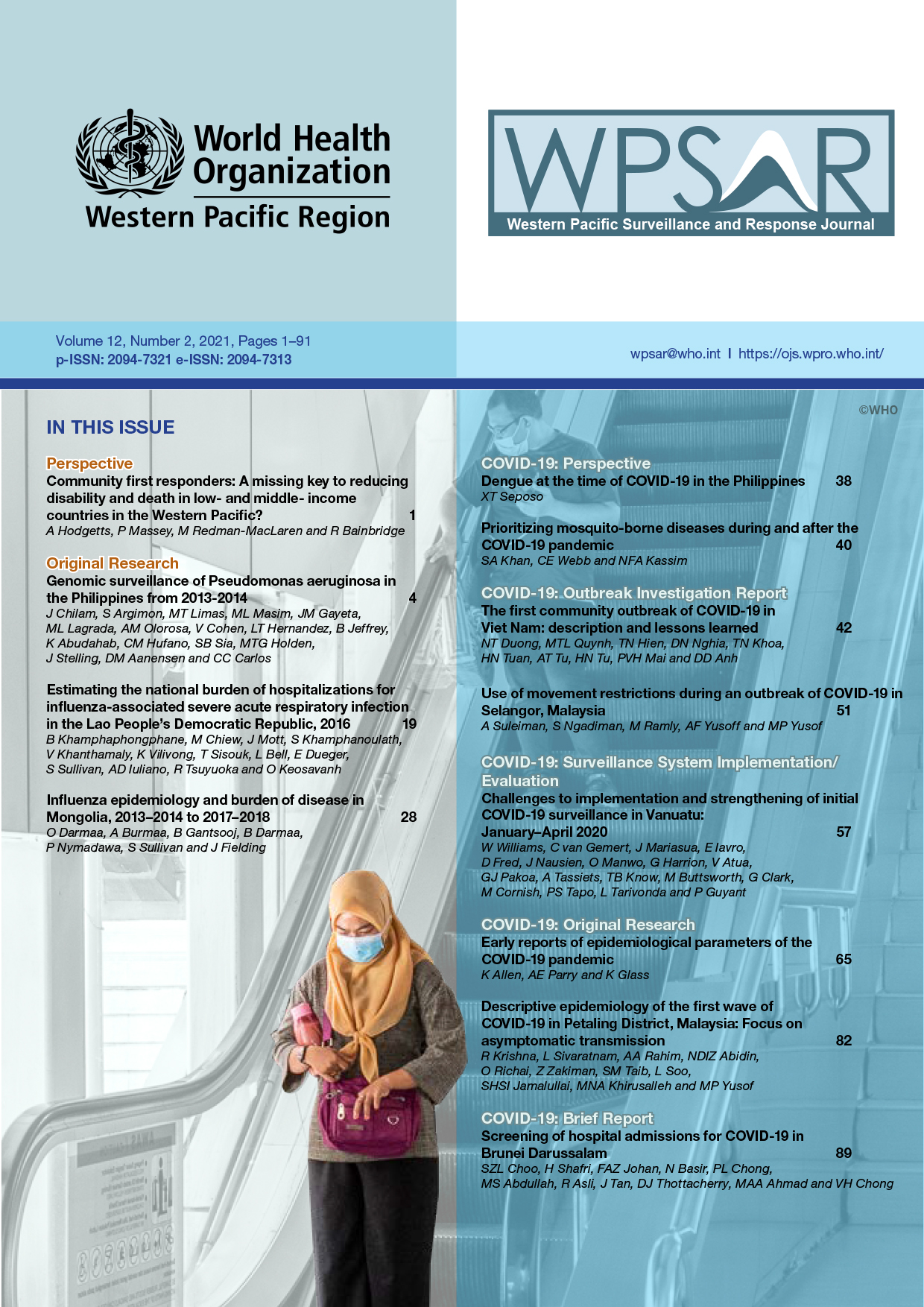Influenza epidemiology and burden of disease in Mongolia, 2013–2014 to 2017–2018
DOI:
https://doi.org/10.5365/wpsar.2020.11.4.003Abstract
Background: Mongolia is a vast, sparsely populated country in central Asia. Its harsh climate and nomadic lifestyle make the population vulnerable to acute respiratory infections, particularly influenza. Evidence on the morbidity, mortality and socioeconomic impact of influenza in Mongolia is scarce; however, routine surveillance for influenza-like illness (ILI), severe acute respiratory infection (SARI) and laboratory-detected influenza is conducted. This paper describes the epidemiology of influenza and the estimated burden of influenza-associated illness in Mongolia in the five influenza seasons between 2013–2014 and 2017–2018.
Methods: Demographic and laboratory data from 152 sentinel surveillance sites on all patients who met the case definitions of ILI and SARI between October 2013 and May 2018 were extracted and analysed as described in A Manual for Estimating Disease Burden Associated with Seasonal Influenza.
Results: The estimated annual influenza-associated ILI and SARI rates, presented as ranges, were 1279–2798 and 81–666 cases per 100 000 population, respectively. Children aged <5 years accounted for 67% of all ILI cases and 79% of all SARI cases. The annual specimen positivity for influenza was highest (11–30% for ILI and 8–31% for SARI) for children aged 5–<15 years and children <2 years old, respectively. The annual mortality rate due to pneumonia and SARI was highest among children aged <2 years (15.8–54.0 per 100 000 population). Although the incidence of influenza-associated ILI and SARI was lowest for people aged >65 years, the mortality rate due to pneumonia and SARI (1.2–5.1 per 100 000) was higher than that for those aged 15–64 years.
Conclusion: The estimated influenza-associated ILI and SARI incidence rates are high in Mongolia, and children, especially those aged <5 years, have the highest influenza-associated burden in Mongolia. These findings provide evidence for decision-makers in Mongolia to consider targeted influenza vaccination, particularly for children.
References
World Health Organization. Influenza (seasonal). https://www.who.int/news-room/fact-sheets/detail/influenza-(seasonal). Accessed May 10, 2018.
World Health Organization. Influenza. https://www.who.int/biologicals/vaccines/influenza/en/. Accessed May 10, 2018.
Simmerman JM, Uyeki TM. The burden of influenza in East and South-East Asia: a review of the English language literature. Influenza Other Respir Viruses 2008;2:81-92.
Lee VJ, Ho ZJM, Goh EH, et al. Advances in measuring influenza burden of disease. Influenza Other Respir Viruses 2018;12:3-9.
WHO Global Influenza Programme. A manual for estimating disease burden associated with seasonal influenza. https://www.who.int/influenza/resources/publications/manual_burden_of_disease/en/. Accessed May 10, 2015.
National Statistics Office of Mongolia. National Statistics Office of Mongolia. http://www.en.nso.mn/index.php. Accessed May 10, 2019.
World Atlas. The coldest capital cities in the world. https://www.worldatlas.com/articles/the-coldest-capital-cities-in-the-world.html. Accessed May 10, 2017.
Mourtzoukou EG, Falagas ME. Exposure to cold and respiratory tract infections. Int J Tuberc Lung Dis 2007;11:938-943.
Nukiwa-Souma N, Burmaa A, Kamigaki T, et al. Influenza transmission in a community during a seasonal influenza A(H3N2) outbreak (2010-2011) in Mongolia: a community-based prospective cohort study. PLoS One 2012;7:e33046.
Burmaa A, Kamigaki T, Darmaa B, Nymadawa P, Oshitani H. Epidemiology and impact of influenza in Mongolia, 2007-2012. Influenza Other Respir Viruses 2014;8:530-537.
The World Bank. World Bank Country and Lending Groups. https://datahelpdesk.worldbank.org/knowledgebase/articles/906519-world-bank-country-and-lending-groups. Accessed May 10, 2019.
Yu H, Huang J, Huai Y, et al. The substantial hospitalization burden of influenza in central China: surveillance for severe, acute respiratory infection, and influenza viruses, 2010-2012. Influenza Other Respir Viruses 2014;8:53-65.
Susilarini NK, Haryanto E, Praptiningsih CY, et al. Estimated incidence of influenza-associated severe acute respiratory infections in Indonesia, 2013-2016. Influenza Other Respir Viruses 2018;12:81-87.
Dawa JA, Chaves SS, Nyawanda B, et al. National burden of hospitalized and non-hospitalized influenza-associated severe acute respiratory illness in Kenya, 2012-2014. Influenza Other Respir Viruses 2018;12:30-37.
Theo A, Tempia S, Cohen AL, et al. The national burden of influenza-associated severe acute respiratory illness hospitalization in Zambia, 2011-2014. Influenza Other Respir Viruses 2018;12:46-53.
Coleman BL, Fadel SA, Fitzpatrick T, Thomas SM. Risk factors for serious outcomes associated with influenza illness in high- versus low- and middle-income countries: Systematic literature review and meta-analysis. Influenza Other Respir Viruses 2018;12:22-29.
Nair H, Brooks WA, Katz M, et al. Global burden of respiratory infections due to seasonal influenza in young children: a systematic review and meta-analysis. Lancet 2011;378:1917-1930.
World Health Organization. Review of the 2013-2014 winter influenza season, northern hemisphere. Wkly Epidemiol Rec 2014;89:245-256.
World Health Organization. Review of the 2014-2015 influenza season in the northern hemisphere. Wkly Epidemiol Rec 2015;90:281-296.
World Health Organization. Review of global influenza activity, October 2015-October 2016. Wkly Epidemiol Rec 2016;91:604-622.
World Health Organization. Review of global influenza activity, October 2016-October 2017. Wkly Epidemiol Rec 2017;92:761-779.
World Health Organization. Review of the 2017-2018 influenza season in the northern hemisphere. Wkly Epidemiol Rec 2018;93:429-444.

